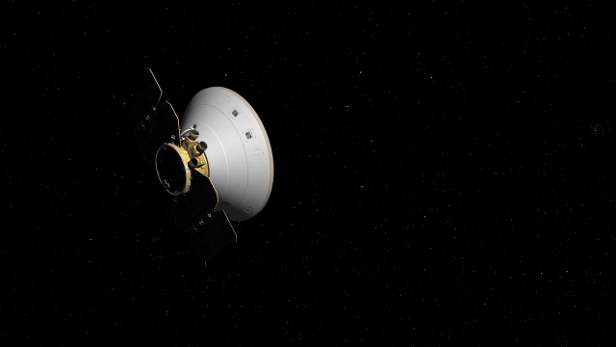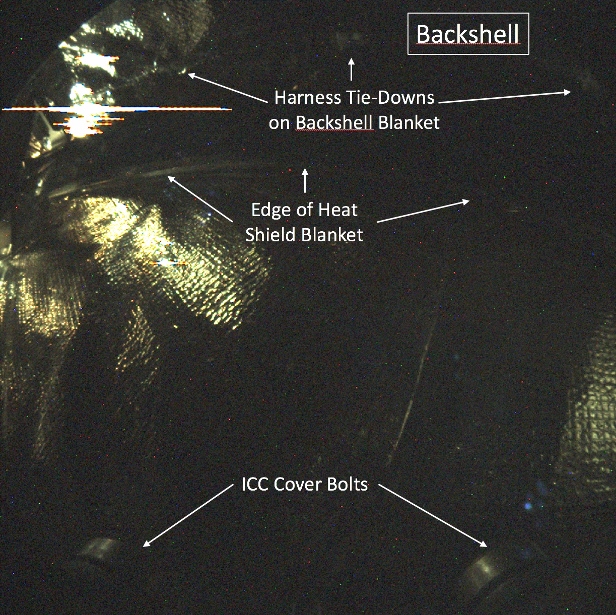NASA’s InSight lander is halfway to its destination
Whilst reaching this milestone, all of its instruments were tested and are thankfully in superb condition

The InSight spacecraft is encapsulated in an aeroshell for protection as it cruises onwards to Mars. Image credit: NASA/JPL-Caltech
NASA’s InSight spacecraft, en route to a 26 November 2018 landing on Mars, passed the halfway mark on 6 August 2018. All of its instruments have been tested and are working well. As of 20 August 2018, the spacecraft had covered 277 million kilometres (172 million miles) since its launch 107 days ago. In another 98 days, it will travel another 208 million kilometres (129 million miles) and touch down in Mars’ Elysium Planitia region, where it will be the first mission to study the Red Planet’s deep interior. InSight stands for Interior Exploration using Seismic Investigations, Geodesy and Heat Transport.
The InSight team is using the time before the spacecraft’s arrival at Mars to not only plan and practice for that critical day, but also to activate and check spacecraft subsystems vital to cruise, landing and surface operations, including the highly sensitive science instruments.
InSight’s seismometer, which will be used to detect quakes on Mars, received a clean bill of health on 19 July 2018. The SEIS instrument (Seismic Experiment for Interior Structure) is a six-sensor seismometer combining two types of sensors to measure ground motions over a wide range of frequencies. It will give scientists a window into Mars’ internal activity.
“We did our final performance checks on 19 July 2018, which were successful,” says Bruce Banerdt, principal investigator of InSight from NASA’s Jet Propulsion Laboratory, Pasadena, California, United States.
The team also checked an instrument that will measure the amount of heat escaping from Mars. After being placed on the surface, InSight’s Heat Flow and Physical Properties Package (HP3) instrument will use a self-hammering mechanical mole burrowing to a depth of 3 to 5 metres (10 to 16 feet). Measurements by sensors on the mole and on a science tether from the mole to the surface will yield the first precise determination of the amount of heat escaping from the planet’s interior. The checkout consisted of powering on the main electronics for the instrument, performing checks of its instrument sensor elements, exercising some of the instrument’s internal heaters, and reading out the stored settings in the electronics module.

A long-exposure image (24 seconds) was taken by Instrument Context Camera (ICC) of NASA’s InSight Mars lander. The image shows some of the interior features of the back shell that encapsulates the spacecraft. Image credit: NASA/JPL-Caltech
The third of InSight’s three main investigations – Rotation and Interior Structure Experiment (RISE) – uses the spacecraft’s radio connection with Earth to assess perturbations of Mars’ rotation axis. These measurements can provide information about the planet’s core. “We have been using the spacecraft’s radio since launch day, and our conversations with InSight have been very cordial, so we are good to go with RISE as well,” says Banerdt.
The lander’s cameras checked out fine as well, taking a spacecraft selfie of the inside of the spacecraft’s back shell. InSight Project Manager Tom Hoffman from JPL says that, “If you are an engineer on InSight, that first glimpse of the heat shield blanket, harness tie-downs and cover bolts is a very reassuring sight as it tells us our Instrument Context Camera is operating perfectly. The next picture we plan to take with this camera will be of the surface of Mars.”
If all goes as planned, the camera will take the first image of Elysium Planitia minutes after InSight touches down on Mars.
JPL manages InSight for NASA’s Science Mission Directorate. InSight is part of NASA’s Discovery Program, managed by the agency’s Marshall Space Flight Center in Huntsville, Alabama, United States. The InSight spacecraft, including cruise stage and lander, was built and tested by Lockheed Martin Space in Denver, Colorado, United States.
Keep up to date with the latest news in All About Space – available every month for just £4.99. Alternatively you can subscribe here for a fraction of the price!




